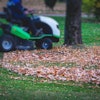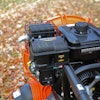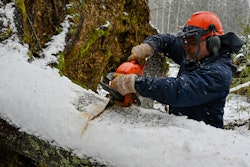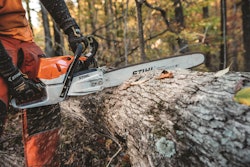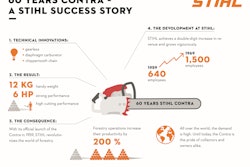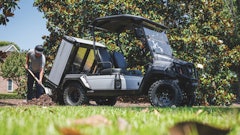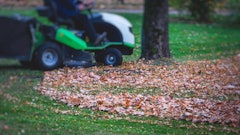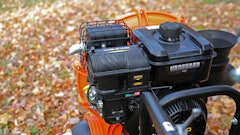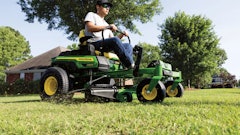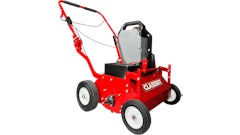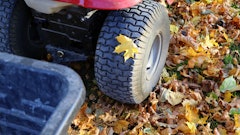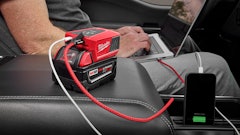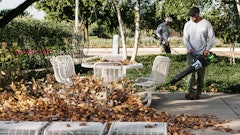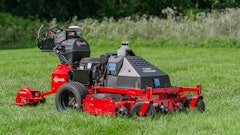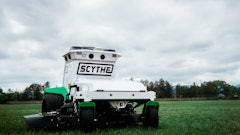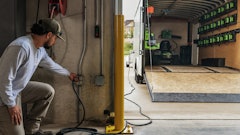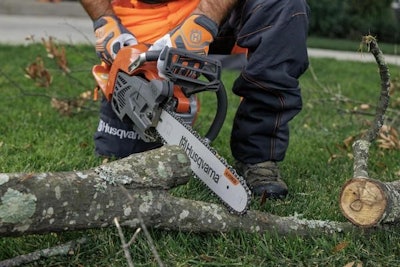
Today’s chainsaws are effective, powerful and quieter tools that do fast work of any tree felling, after storm cleanup or property beautification. Chainsaws can also be very dangerous if used improperly. For landscape professionals doing occasional tree work for their clients, the key to safe use is employing the correct working techniques, outfitting workers with personal protective equipment (PPE) and choosing a modern chainsaw with functioning safety features and always keeping safety top of mind.
The typical commercial landscaper is less likely to be aware of the inherent dangers of working with a chainsaw, especially battery-powered chainsaws, because they work with these tools infrequently. There’s often a misconception that battery saws won't and can't hurt you, and landscapers tend to underestimate the need for proper PPE. When using a chainsaw, yes, landscapers need head protection, yes, they absolutely need chaps to protect their legs and yes, appropriate footwear is a must. That’s in addition to the rest of the normal PPE. Being cut with any chainsaw is serious business, and the less your crew is exposed to them, the less opportunity there is for training and ensuring appropriate PPE is available. It's also important to train crews so they have foundational knowledge of kickback and what parts of the guide bar are appropriate for use.
Sharing and emphasizing safety guidelines with team members when tree work is on the schedule is essential. Though some of the protocols below may seem common sense, it is important they are enforced and kept top of mind no matter how long or short the job is. The following guidelines were aggregated from veteran tree care professionals.
Safety first checklist
Go through this safety primer checklist before even picking up a chainsaw.
- Invest in training your team through an area training course. If you can’t find an arborist in your area, you can also look at online courses, some of which are free.
- Evaluate surroundings and the task at hand. Determine if the job can be done safely by the crew and does not impact surrounding workers or property.
- Don proper safety gear including a helmet, protective glasses, certified protective chainsaw pants or chaps, boots and gloves.
- Always start a chainsaw on flat ground or in leg lock position with the chain brake engaged.
- It’s important to realize limitations. If you or a crew member expresses hesitancy in undertaking tree work for any reason, opt out and consult a tree professional in your area.
Fit for correct use
Plan for safety before you start the job by having your equipment checked by professionals, like a dealer, on a regular schedule. Make sure your chain is sharp and that you have the proper chain tension. It’s also a good idea to have high-quality replacement chains (like those offered by manufacturers such as Husqvarna) that are sharp and ready to go should you need to swap one out. Make sure that your crew is confident with their tools and is aware of the built-in safety features of your chainsaw of choice which should include components like a kickback guard, chain brake, throttle lock, chain catcher, right-hand guard and stop control.
Watch out for common issues
Knowing what can go wrong when using a chainsaw and watching for these occurrences and responding accordingly is critical. When working with a chainsaw keep an eye out for the following.
- Kickback is a reactive force during chainsaw usage that can cause lack of control and injury. Avoid the greatest risk of kickback by avoiding any cutting using just the tip or nose of the chainsaw guide bar and employing a proper grip on the saw and stance while cutting.
- Pinching or getting a chainsaw stuck in a tree or log can set up a dangerous situation. Avoid pinching the bar by determining how branches are tensioned and cutting on the compression side of the branch where the guide bar is not likely to be pinched under the weight of the branch. If unsure, cut the branch in stages from the outside in toward the trunk.
- Controlled action, especially when moving with a chainsaw, is key. Always hold the guide bar on the other side of a trunk when you move your feet. Chains must be static when you move, and hold the saw by both handles when moving short distances, never by the rear handle only. The chain brake should be engaged when taking three or more steps, and the saw should be carried by the front handle with the guide bar facing behind you.
Body work
To handle a chainsaw properly and effectively, your body and the tool must work together in tandem.
- A steady grip is necessary on both handles on a saw. Thumbs and fingers must be completely wrapped around the handles. Hold the thumb of your left hand under a front handle to reduce the force of a possible kickback.
- Holding the chainsaw close to the body instead of at arm’s length allows for better balance, control and reduces weight fatigue.
- Standing with feet apart and the left foot slightly in front of the rights is the best stance for balance.
- Bend your knees to avoids back aches and prevent yourself from erroneously leaning over the chainsaw when working in low positions.
Chainsaws are important tools to have at your disposal as a landscaper, but for crews that don't use them regularly, they can be intimidating and dangerous. Keep these safety guidelines in mind to ensure any team members who will perform tree work can do so safely and successfully.


